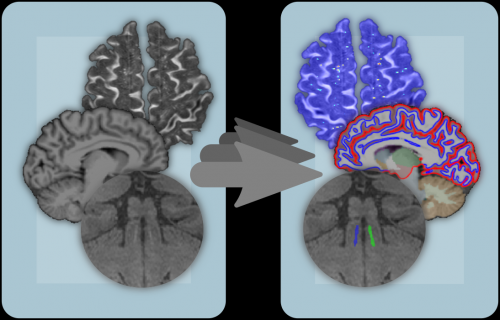Automated feature extraction and data classification

The extraction of features, such as volumes and thickness values, often involves the segmentation of relevant parts of the images, such as certain subcortical brain structures or potentially occurring pathologies like metastases and the effects of microangiopathies. For small patient cohorts, a manual segmentation may be generated with reasonable effort. However, for larger cohorts with hundreds to thousands of individuals, automatic, fast, and robust segmentation algorithms are required.
In this research area, we adapt State-of-the-Art approaches, which usually work well for high quality clinical research data, to data from clinical routine with a reduced quality. Moreover, we develop algorithms in the promising field of deep learning. For instance, in collaboration with the working group “Mixed cerebral pathologies and cognitive aging” (Stefanie Schreiber) at the Department of Neurology at the Otto-von-Guericke University, we address the segmentation of enlarged perivascular spaces in Magnetic Resonance Imaging (MRI) data using neural networks.
In contrast to the large number of imaging studies stored in the hospital repositories, the number of annotations available for these data is usually small. This lack of ground truth is crucial when applying mostly supervised machine learning techniques like convolutional neural networks (CNNs). Hence, we focus in this research area on the development of weakly supervised and unsupervised techniques and address questions such as how much ground truth is necessary as training basis for a successful prediction and which data samples constitute an ideal training set?
Features are derived from segmentation results but also from the original image data, e.g., by texture and fractal analyses. Altogether, these features can contribute to the determination of biomarkers as well as to the classification into healthy and pathologic. In this research field, we develop classification approaches based on extracted features and alternatively, on classified training samples without previous features extraction. Moreover, we investigate the inclusion of non-image patient data, such as personal data (age, gender, BMI,…), treatment data (medication, blood pressure, laboratory values,…), clinical history data (diagnoses, therapies) and lifestyle data (physical exercise, nutrition, alcohol and tobacco consumption,…), in this approach.





